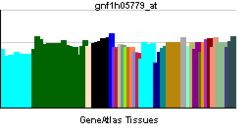OR2M4
Olfactory receptor 2M4 is a protein that in humans is encoded by the OR2M4 gene.[2][3][4]
Olfactory receptors interact with odorant molecules in the nose, to initiate a neuronal response that triggers the perception of a smell. The olfactory receptor proteins are members of a large family of G-protein-coupled receptors (GPCR) arising from single coding-exon genes. Olfactory receptors share a 7-transmembrane domain structure with many neurotransmitter and hormone receptors and are responsible for the recognition and G protein-mediated transduction of odorant signals. The olfactory receptor gene family is the largest in the genome. The nomenclature assigned to the olfactory receptor genes and proteins for this organism is independent of other organisms.[4]
See also
References
- ↑ "Human PubMed Reference:".
- ↑ Parmentier M, Libert F, Schurmans S, Schiffmann S, Lefort A, Eggerickx D, Ledent C, Mollereau C, Gerard C, Perret J, et al. (Mar 1992). "Expression of members of the putative olfactory receptor gene family in mammalian germ cells". Nature. 355 (6359): 453–5. doi:10.1038/355453a0. PMID 1370859.
- ↑ Vanderhaeghen P, Schurmans S, Vassart G, Parmentier M (Apr 1997). "Specific repertoire of olfactory receptor genes in the male germ cells of several mammalian species". Genomics. 39 (3): 239–46. doi:10.1006/geno.1996.4490. PMID 9119360.
- 1 2 "Entrez Gene: OR2M4 olfactory receptor, family 2, subfamily M, member 4".
Further reading
External links
This article incorporates text from the United States National Library of Medicine, which is in the public domain.
|
|---|
|
Class I
(fish-like specific receptors) | Family 51 | |
|---|
| Family 52 | |
|---|
| Family 56 | |
|---|
|
|---|
|
Class II
(tetrapod specific receptors) | Family 1 | |
|---|
| Family 2 | |
|---|
| Family 3 | |
|---|
| Family 4 | |
|---|
| Family 5 | |
|---|
| Family 6 | |
|---|
| Family 7 | |
|---|
| Family 8 | |
|---|
| Family 9 | |
|---|
| Family 10 | |
|---|
| Family 11 | |
|---|
| Family 12 | |
|---|
| Family 13 | |
|---|
|
|---|

 . PMID 14983052.
. PMID 14983052.